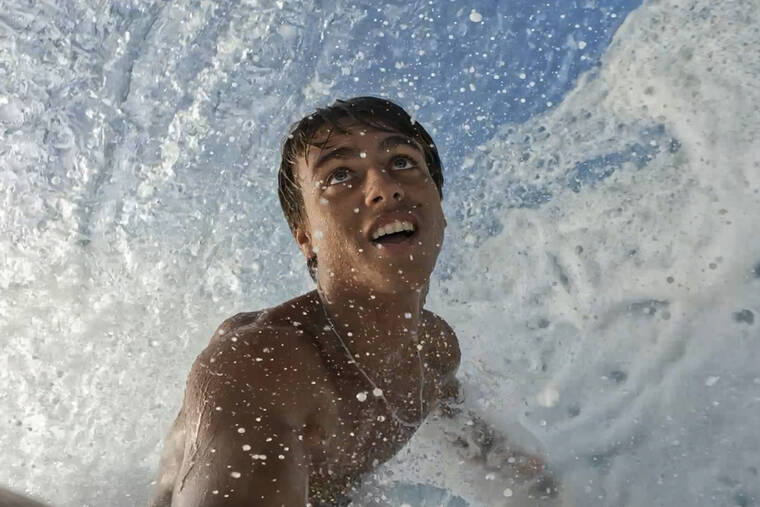
PARIS >> The giant waves form in the storm belts of the Southern Ocean, off Antarctica, where whales roam. Supercharged by intense winds, the swells then roll on an ocean journey of thousands of kilometers (miles) to crash into Tahiti in the South Pacific.
There, in the waters of the volcanic island that will host next year’s Olympic surfing events, surfer Kauli Vaast waits.
If the Tahitian-born 21-year-old catches one of the waves just right, he’ll harness its awesome power as it rears up to become a furious, frothing wall of water. If he stays upright, he’ll zip through the crystal-blue tunnel that forms around him as the wave breaks, emerging unscathed and whooping, with a grin on his face.
“Just the most perfect wave in the world,” says Vaast, who hopes the island’s legendary surfing conditions are his ticket to a gold medal.
The decision to hold Olympic surfing in French Polynesia next July will require competitors to brave some of the world’s biggest waves. The location promises more dramatic television images than when the sport made its Olympic debut at the Tokyo Games in 2021. Then, the waves on Tsurigasaki Beach were sometimes modest, and COVID-19 dented the atmosphere.
But the faraway venue has also raised pointed logistical and environmental questions because the rest of the Summer Games are focused in the host city, Paris, nearly 16,000 kilometers (10,000 miles) and 10 time zones away.
The need to fly 48 surfers, judges, journalists and others that far looks awkward against Paris organizers’ stated ambition of reducing the Olympics’ carbon footprint by half. Four other surf spots that also bid were dotted along France’s Atlantic coast and could easily have been reached by train and bus from the French capital.
But for big-wave enthusiasts like Vaast, Tahiti makes sense because it has Teahupo’o, a village on the southern shore with lagoons that get the full force of the swells, generating dream surf for the courageous.
“If the conditions are really good, it’s going to be a great contest to watch,” Vaast says. The Olympics “are going to be like crazy.”
Teahupo’o translates from Tahitian as “wall of heads.” The name refers to a tribal battle where heads were severed, but it’s also appropriate for such fearsome waves. The deep ocean bed rises steeply on final approach to Teahupo’o’s offshore reefs, forcing the water into towering walls and huge, rolling tubes.
They are perilous. Surfers who fall risk being body-slammed onto the sharp and shallow corals, which tore chunks off the face of Hawaiian surfer Keala Kennelly when she tumbled in 2011.
Because Teahupo’o’s surf breaks offshore, the Olympic judges have to be out in the lagoon, too. Organizers intend to install them and television cameras on an aluminum tower that will be attached to the reef. That plan has sparked protests in Tahiti. Its critics fear for coral and other marine life.
Tahitian surfer Matahi Drollet is one of the most vocal opponents. His protest videos on Instagram have racked up hundreds of thousands of views.
Vaast acknowledges widespread concern about the Olympics’ footprint in the Teahupo’o lagoon, saying: “We (are) all scared if they’re doing something big.”
But he also expects the Olympic spotlight to boost the tourism industry that underpins the Tahitian economy.
“It’s going to be great to see a lot of people getting interested in French Polynesia,” he says. “And with the construction for the Olympics and stuff, it creates a lot of work for the local people.”
Vaast is one of only two French Polynesian surfers qualified so far. The other is Vahine Fierro in the women’s competition. Growing up surrounded by the vast Pacific, Vaast swam, fished and surfed as a kid and was just 8 when he first tackled Teahupo’o waves.
He remembers being terrified of their reputation, but he was hooked by their beauty and power. Tahitians say the waves have “Mana,” life-affirming spiritual energy. Vaast believes that his intimate knowledge of Teahupo’o gives him home-field advantage and the “chance of a lifetime” in July.
“I feel this energy nowhere (else) in the world, only in Tahiti, at Teahupo’o,” says Vaast, who often travels on the surfing circuit. “When you go there, you need to be respectful because if you respect (it), like the ocean is going to respect you.”
For France, the Tahitian venue will allow the host country to highlight its long historical ties to the Pacific and involve its far-off overseas territories in the Summer Games.
Teahupo’o, Tahiti’s jewel, is primed to wow.
“When you’re in the barrel, you see the mountains” and colors that are “super clear,” Vaast says. “You can see the corals underneath. … Beautiful. The most beautiful place in the world.”
Read More: World News | Entertainment News | Celeb News
Star Ads






